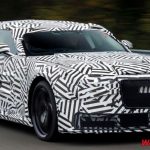The few vehicles make a statement quite like the Hummer H2. Nicknamed “The Beast,” this larger-than-life SUV is a symbol of excess, capability, and pure American muscle. Whether you love it or loathe it, there’s no denying that the H2 is a legend in its own right.
Born from the Battlefield
The Hummer H2 has its roots in military hardware. Its predecessor, the original Hummer H1, was a civilian adaptation of the Humvee—an all-terrain military vehicle built by AM General. While the H1 was built like a tank and offered extreme off-road capabilities, it wasn’t practical for everyday driving. Enter the H2.
Produced between 2002 and 2009, the Hummer H2 was GM’s attempt to tame the beast without killing its spirit. It was slightly smaller than the H1, more refined, and came with creature comforts that made it suitable for daily use. But don’t let that fool you—the H2 still packed enough muscle to chew through snow, sand, and rock with ease.
Design That Demands Attention
One of the most striking things about the H2 is its aggressive, boxy design. With wide fenders, a high ground clearance, and a grille that screams dominance, it’s a vehicle that commands respect. Even parked, the H2 looks like it’s ready for war. Its upright windshield, squared-off roof, and massive tires complete the look.

This is not a vehicle you can blend in with. It turns heads wherever it goes—whether that is admiration or criticism. Critics often point to its size and fuel consumption, while fans celebrate its bold, in-your-face attitude. Either way, the H2 never goes unnoticed.
Power Under the Hood
The Hummer H2 was not just about looks. Under its hood was a 6.0-liter V8 engine, later upgraded to a 6.2-liter V8 that produced 393 horsepower and 415 lb-ft of torque. That’s more than enough to get its 6,400+ pound frame moving with authority. It wasn’t the fastest SUV on the road, but it didn’t need to be. The H2 was built to conquer terrain, not win races.
Mated with a 4-speed (later 6-speed) automatic transmission and full-time four-wheel drive, the H2 offered serious off-road capability. It could climb 16-inch vertical obstacles, wade through nearly 20 inches of water, and handle a 60% grade. Skid plates and a high-approach angle made it trail-ready right out of the showroom.
Interior: Rugged Meets Refined
Inside, the H2 was surprisingly luxurious for such a brutish machine. Leather seats, dual-zone climate control, a premium sound system, and available rear-seat entertainment made it a comfortable ride for long trips.
It was not the most spacious SUV in terms of cargo space (especially with the third row in place), but it had enough room for a family or group of adventurers and their gear. Plus, it had that unmistakable feeling of riding in something different, something special.
Fuel Economy? Not Its Strong Suit
Let’s address the elephant in the room: fuel economy. The Hummer H2 was never meant to be efficient. With an average of 10–13 MPG, it drank gasoline like a fish drinks water. In today’s eco-conscious world, that’s a hard pill to swallow.
However, for many H2 owners, this was not a deal-breaker. They bought the H2 knowing full well it was a gas guzzler. What they got in return was a vehicle that could take them places few others could—with a style that was unmistakably its own.
Final Thoughts
The Hummer H2 remains a cultural icon. It’s not just a vehicle; it’s a statement. It represents a time when bigger was better, when off-road capability and brute strength mattered more than miles per gallon or parking ease.
The H2 is a relic of an irresponsible era. To others, it’s a badass machine that dares to be different. Love it or hate it, the Hummer H2 will always be remembered as The Beast that roared through the streets and trails, leaving an indelible mark on automotive history.










